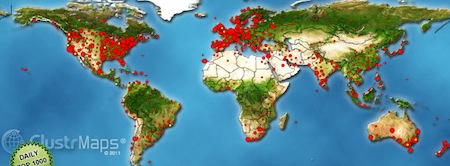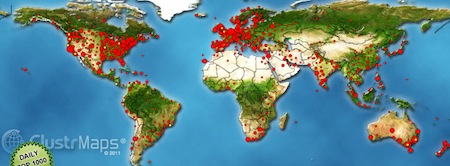This is an auspicious day. On this day in 2009 BiM published its first blog post. We have come a long way since a conversation a bit over three years ago when Heidi persuaded Lorimer to try blogging as a new way to help overcome the divide between scientist and clinician.
Now we have about 3,800 visits to the site EVERY week from all over the world. Over 3,000 people follow us on Facebook, many of them making regular contributions. Our LinkedIn group has another, somewhat different, group of people who regularly comment, and for you twitterphiles – thanks for the retweets and the good information you push our way.
Our regular visitors are poles apart geographically, Alsace, Argolis, Azuay, Adis Abeba, Paramaribo, Peterborough, Puebla and Plzensky – and come from a diverse mix of professions and contexts. We even had a visitor from Petropavlovsk-Kamchatsky.
So, what have we achieved? Well, that’s a good question and a matter of ongoing debate within the BiM team.
We have a network of collaborators from around the world, we have achieved a Klout score of 56 (Klout is a measure of influence across some of the main social networks) and we are holding our own among the ‘big’ journals like the Lancet (85), Nature medicine (61), JAMA (62), Annals of Internal Medicine (54), and the Canadian Medical Association (55).
What is more, according to Klout, we are the single most influentual clincial pain sciences presence in the blog/social media domain. Not that we think that is necessarily a good thing – we would love the journals and the IASP to be out there, which they are not: many of the clinical pain science journals are yet to properly dip their toe into the water of social media.
We have promoted charity events, bike rides, advertised phds, post docs, undertaken a clandenstine experiment (you didn’t know we were doing that did you!?!?!) and generally spread good cheer. We have even triggered emails from the Australian National Health and Medical Research Council as to the benefits or not of blogging. Lorimer thinks we may be another straw on the back of the “the only impact is via citations” camel.
Have we made a difference to you? Well, it seems you read the posts and comment so, maybe, we have made a small difference in furthering pain research dissemination. I am currently working with Lorimer and some others in trying to better measure what it is we are actually achieving.
Thanks everyone for your contributions, hard work, and for those of you who have blogged a special thank you. It is not an easy task to write about a piece of research in 400 words, make it robust and make sense, and then take the time to answer comments and questions.
Heidi Allen
 We reckon that an all too common problem with ‘science’ is that it is only ever broadcast to ‘scientists’. Even then, it is often in journals that are read by a tiny proportion of the community. So, we sat down and thought ‘how can we better disseminate what we do – that is, how do we get the message out there, be a credible and interesting source of commentary on things to do with our research?’ How can we facilitate all those lovely ideas out there into research? Our answer: Heidi. Heidi has set up, run, bugged us all about contributing to this website. She reckons it will serve the aim of the group – to disseminate and facilitate research into the brain and mind in chronic pain disorders. We reckon she is right. Here she is, in person, talking about what she does at BodyInMind.
We reckon that an all too common problem with ‘science’ is that it is only ever broadcast to ‘scientists’. Even then, it is often in journals that are read by a tiny proportion of the community. So, we sat down and thought ‘how can we better disseminate what we do – that is, how do we get the message out there, be a credible and interesting source of commentary on things to do with our research?’ How can we facilitate all those lovely ideas out there into research? Our answer: Heidi. Heidi has set up, run, bugged us all about contributing to this website. She reckons it will serve the aim of the group – to disseminate and facilitate research into the brain and mind in chronic pain disorders. We reckon she is right. Here she is, in person, talking about what she does at BodyInMind.




